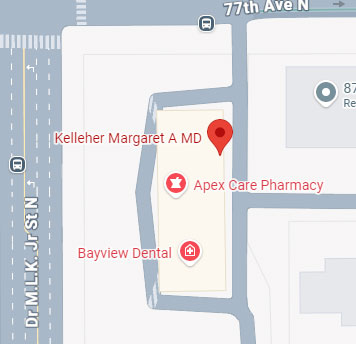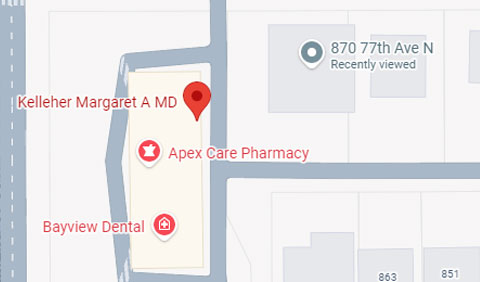All About Skin Cancer
Prevention, Diagnosis, Treatment, and More for St. Petersburg, St. Pete Beach (South Pasadena), and Tampa Bay
The Nelson Dermatology team knows that sun damage is a reality for everyone living in Florida. Unfortunately, while some of this damage is cosmetic—such as wrinkles and freckles—there is also an important medical side, with the most serious health consequence being skin cancer. In Tampa Bay's St. Petersburg and South Pasadena, Dr. Andrew Nelson, Dr. Christopher Nelson, Dr. Lana McKinley, and their team pride themselves on being able to diagnose, address, and care for this very significant disease.
An estimated 20 percent of all Americans will develop some form of skin cancer by the time they turn 70. While most cases of skin cancer are relatively slow growing and can have high cure rates, the problem is still a potentially fatal one. There are more than two deaths due to skin cancer per hour in the United States. The Nelson Dermatology team strongly encourages everyone to focus on prevention—one of the most effective strategies in the fight against skin cancer— and emphasizes the importance of regular skin checkups to monitor your skin for any concerning areas. We encourage everyone to seek professional dermatologic help as soon as possible if they notice a suspicious spot, mole, or lesion. A rapid diagnosis and treatment can be imperative for a positive outcome, especially in cases of melanoma, the deadliest form of skin cancer.
Schedule your consultation for skin cancer in St. Petersburg or St. Pete Beach (South Pasadena). Call Tampa Bay's Nelson Dermatology at (727) 895-8131.
What Is Skin Cancer?
Skin cancer is the uncontrolled growth of certain skin cells, typically caused by damage from a lifetime of ultraviolet light exposure. While there are many different types of skin cancer, the disease is generally divided into two categories: non-melanoma and melanoma.
Non-Melanoma Skin Cancers
The most common form of skin cancer is basal cell carcinoma. This skin cancer develops from the basal cell layer of the epidermis, the outermost layer of your skin. Normally, basal cells grow and divide in a regulated manner. As new basal cells are formed, they push older skin cells up toward the skin surface. These skin cells eventually reach the surface where they die and either flake away on their own or get removed via abrasion as part of a skincare regimen or treatment.
Basal cell carcinoma develops when ultraviolet light from the sun or tanning beds damages the DNA inside a basal cell. This damaged DNA tells the basal cell to keep growing and dividing rapidly instead of following the normal process. Eventually, this results in the appearance of a basal cell carcinoma skin cancer. Typically, these lesions present as a shiny or "pearly" translucent bump on the skin that doesn't heal. Other, less common appearances—such as dark spots or scar-like lesions—can also occur. Typically, basal cell carcinomas may crust, scab, or bleed, but do not heal on their own. Fortunately, the majority of basal cell carcinomas do not spread (metastasize) throughout the body—but if not treated, these skin cancer lesions can grow and destroy your normal skin cells.
The second most common form of skin cancer is cutaneous squamous cell carcinoma. Squamous cell carcinoma develops from the squamous layer of the skin, which makes up the middle and outer layers of the epidermis. Again, similar to basal cells, the squamous layer of the skin normally grows and divides in a regulated continual cycle, with the squamous cells eventually dying and being shed when they reach the surface of the skin.
Squamous cell carcinoma develops when ultraviolet light damages the DNA of a squamous cell. Some people with weakened immune systems or certain genetic disorders can also be at increased risk of squamous cell carcinoma. Squamous cell carcinoma typically presents as firm, red, scaly bumps most commonly in sun-exposed skin. Squamous cell carcinoma is more aggressive than basal cell carcinoma. While most squamous cell carcinomas are not life threatening, these skin cancer lesions can grow relatively quickly and, if untreated, have the potential to spread inside your body to lymph nodes or other internal organs. Prompt diagnosis and treatment are therefore very important.
Melanoma
While rare, melanoma is the deadliest form of skin cancer, developing in the pigment-forming cells in the skin known as melanocytes. This cancer can quickly develop, rapidly grow, and even work its way beyond the initial site, spreading throughout the body and leading to the presence of cancer in other organs and systems known as metastases.
There are several different subtypes of melanoma, each presenting slightly differently. Typically, we think of melanomas as being irregularly colored, asymmetric spots with irregular borders. But melanomas can also present as a blue-black or red bump on the skin. While some melanomas may develop in an old, existing mole, most melanomas develop on normal skin. Melanomas can even develop on the palms or soles or underneath a finger/toenail.
While melanoma can be deadly in advanced forms, if diagnosed and treated at an early stage, it can have a very good prognosis. Stage 0 (melanoma in situ) and Stage I melanoma have a five-year survival rate of over 98 percent. By contrast, Stage IV (the most advanced melanoma) only has a five-year survival rate of 25 percent. As you can see, early diagnosis and treatment of melanoma can have a profound impact on outcome. That is why it is so important for patients with a diagnosis of melanoma or any new or changing moles to be evaluated promptly by a board-certified dermatologist, such as the specialists at Nelson Dermatology.
Actinic Keratoses
Scaly or waxy patches that develop due to sun damage may be actinic keratoses (AKs), which are pre-malignant lesions. These lesions may not be cancerous yet, but they can develop into skin cancer over time. As a result, the Nelson Dermatology team encourages treatment of these lesions early to prevent future problems. There are several different methods available for treating actinic keratoses, including cryotherapy (liquid nitrogen treatment), topical chemotherapeutic agents, and light therapy such as photodynamic therapy. You can rest assured that the Nelson Dermatology team can confidently and effectively utilize any or all of these options to treat and clear your pre-cancerous actinic keratoses.

What Causes Skin Cancer?
Skin cancer may develop due to a range of factors, including genetic disposition and environmental exposures, but the most common cause is ultraviolet radiation. Ultraviolet radiation is the energy that radiates from the sun and is produced by tanning beds. Shorter term exposure to ultraviolet radiation can cause the skin to redden or peel from a sunburn or slowly cause the skin to darken in a tan. The longer term effects of ultraviolet radiation are potentially much more dangerous.
Ultraviolet radiation can penetrate beneath the surface of the skin and damage cutaneous cells. The radiation can ultimately change and damage the DNA of the skin cells, altering their "programming" so that the skin cells begin to grow and divide in an unregulated manner instead of the typical controlled manner. This unregulated growth and cell division is the basis for the development of skin cancer. Since the development of skin cancer is so closely associated with ultraviolet exposure, it is no surprise that skin cancers tend to appear on parts of the body routinely exposed to the sun, including the face.
Both cumulative and intense exposure to ultraviolet radiation can be harmful. Having five peeling sunburns alone can double a person's risk of developing deadly melanoma. As a result, the team at Nelson Dermatology strongly encourages everyone to follow sunwise precautions and be safe in the sun.
What Are Good Ways to Prevent Skin Cancer?
Anything you do to avoid ultraviolet radiation exposure can lower your risk of developing skin cancer. Most simply, you can stay out of the sun or limit your sun exposure—especially during peak hours from 10 a.m. to 4 p.m. when ultraviolet radiation is at its strongest. If you do go out in the sun, wear sun-blocking clothing as much as possible, including long sleeves and pants, closed-toed shoes to protect the top of your feet, sunglasses, and a tight-weave hat that guards your scalp and the tops of your ears, as well as shades your face. Many clothes now have ultraviolet protection "built in." These special fabrics will have a UPF label that indicates their ability to help block ultraviolet radiation and protect you from the sun. Fabrics with a UPF greater than 50 block 98 percent of ultraviolet light from getting to your skin.
Exposed skin should be covered with sunscreen to help protect you. Many patients ask us what the "best" sunscreen is. While we typically avoid recommending a specific brand, there are some important characteristics to look for in a good sunscreen. The sunscreen should have an SPF (sun protection factor) of at least 50. The sunscreen should be labeled "broad spectrum," indicating its ability to block both ultraviolet A and ultraviolet B rays. Finally, in Florida, where it is always humid and it seems like we are always sweating, we encourage people to utilize sunscreens that say "water-resistant, 80 minutes."
Just as important as choosing the right sunscreen, it is critical to put it on correctly. Most people make the mistake of not putting enough sunscreen on or not reapplying it throughout the day. These mistakes make the sunscreen much less effective. Apply a shot glass' worth (1 ounce) of sunscreen in a single layer to all exposed skin about half an hour before venturing outdoors, and then another layer right before heading out. The "water-resistant, 80 minutes" label indicates that the sunscreen should be reapplied every 80 minutes if you are sweating or swimming or the sunscreen may have been washed away. Even if you are not swimming or sweating, it is important to reapply your sunscreen every two hours throughout the day to protect your skin.
Be aware that sunny days are not the only times ultraviolet radiation reaches the surface and damages your skin. Clouds may keep us from seeing the sun, but they do not block its rays. Cover up and/or wear sunscreen even when it's overcast.
Meet our Doctors
Get to know our board-certified dermatologists serving St. Petersburg, St. Pete Beach and all of the Tampa Bay area.





What Is a Skin Cancer Check?
Routine self-checks for new or changing moles and lesions can literally be lifesaving. By developing a familiarity with the number, location, size, and appearance of spots on your body, you can put yourself in an ideal position to notice when something seems off. While we encourage you to get familiar with your skin, we do not expect you to know what all these lesions are and which ones are dangerous. That is our job. The team at Nelson Dermatology will examine your entire skin surface, including the areas that are much harder for you to keep an eye on—like your back—to monitor for any concerning spots. If we discover a suspicious or worrisome patch or bump, or you notice a new or changing spot yourself, we will closely examine the spot with our eyes and special tools called dermatoscopes to help us determine what it is. We may also perform tests, including a small skin biopsy, to determine the exact etiology of the lesion and whether skin cancer cells are present.
During self-checks, watch for what dermatologists call the ABCDE's of skin cancer:
A is for Asymmetry. Cancerous lesions tend to be lopsided, featuring halves that are not mirror images of each other—unlike more typically round benign growths.
B is for Border. Moles and other non-cancerous lesions often have a smooth border, while skin cancer creates notches, scallops, and otherwise irregular or poorly defined edges.
C is for Color. Skin cancer can cause growths to appear mottled and multicolored, as opposed to a uniform hue. Also, watch for unusual colors like blue or white.
D is for Diameter. If a mole is larger in diameter than a pencil eraser, it should be examined for the presence of skin cancer.
E is for Evolving. Benign lesions don't change much over time, while the uncontrolled growth of skin cancer cells causes malignant lesions to develop new shapes, colors, and sizes—sometimes rapidly.
Another sign to watch for is the "Ugly Duckling." If a skin lesion stands out from those around it—whether because it's much larger, a different shade, or an unusual shape—it should be examined for potential skin cancer.
What Skin Cancer Treatments Are Available at Tampa Bay's Nelson Dermatology?
Nelson Dermatology specializes in the diagnosis and treatment of skin cancer. There are many treatment options for skin cancer, depending on the exact diagnosis, subtype, and location on your body. Rest assured, we can discuss the options and help you select the best treatment option.
Nelson Dermatology specializes in the surgical treatment of skin cancer with our board-certified and American College of Mohs Surgery-certified physician, Dr. Andrew Nelson. Mohs surgery is a specialized, precise treatment option available for patients with skin cancer. This precision excision procedure involves Dr. Nelson meticulously removing tissue layer by layer, examining each sample closely under a microscope to determine when all of the skin cancer has been removed. This technique has the highest cure rate of any skin cancer treatment, as it is the only technique that examines the entire surgical margin. This allows the physicians at Nelson Dermatology to offer the highest cure rate while preserving the maximum amount of healthy tissue.
Once the skin cancer has been completely removed, reconstructive surgery for the area will then be performed. Dr. Andrew Nelson is specially trained in reconstructive surgery following Mohs and has completed advanced training at Harvard and UCLA. Our team will be able to offer you the most comprehensive, effective reconstructive treatment needed for your skin cancer.
Mohs surgery is not the only treatment method for skin cancer. A simple surgical excision may be sufficient for treating your skin cancer. A surgical excision involves removing the skin cancer that can be seen with the naked eye, as well as a rim of normal appearing skin (a safety margin) around the area. This excision is then sent out to a lab to be evaluated. While the skin is examined under a microscope, only a fraction of the surgical margin is evaluated when compared to a Mohs technique. This treatment is a good option for small skin cancer lesions in less cosmetically sensitive areas, such as the trunk, arms, or legs. When used appropriately, standard surgical excisions can be a good option with a high cure rate and good cosmetic outcome.
Other options involve the treatment of the skin cancer without examining the tissue under a microscope. These treatments include radiation, topical chemotherapy creams, photodynamic therapy, and electrodessication and curettage (sometimes referred to as "scrape and burn"). All of these treatment options typically have a lower cure rate compared to surgery, as there is no way to be certain that all of the skin cancer has been removed or treated. Instead, the cure rate is based on clinical trials and previous experience to inform the physician of how much skin to treat. While standard surgical excisions have a cure of 95 percent, and Mohs surgery has a cure rate of 99 percent, options such as topical chemotherapy creams and electrodessication and curettage may only have a cure rate of 50 to 75 percent.
The physicians at Nelson Dermatology pride themselves on staying up to date on all of the most advanced treatment options for skin cancer. It is our job to help educate you by discussing your options and helping you to select the best treatment for your skin cancer. This is what we mean when we say "caring for you and your skin".
Schedule your consultation to discuss skin cancer in St. Petersburg or St. Pete Beach (South Pasadena). Call Nelson Dermatology in Tampa Bay at (727) 895-8131.








